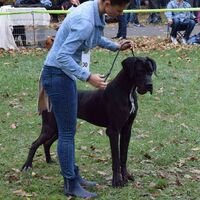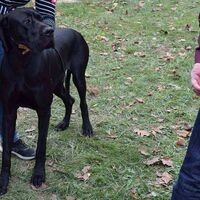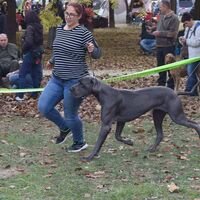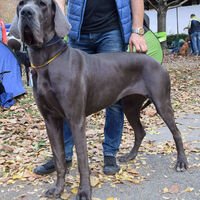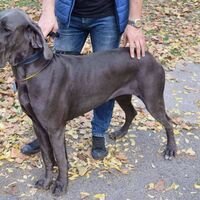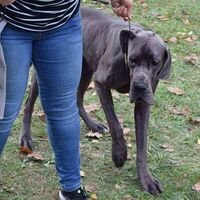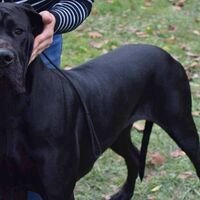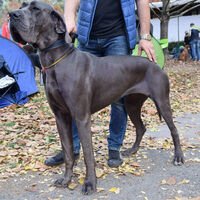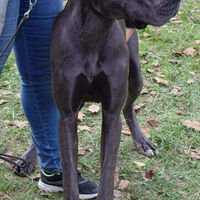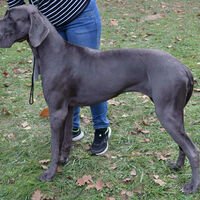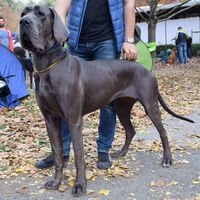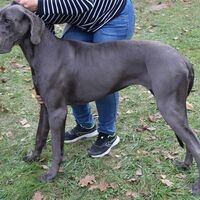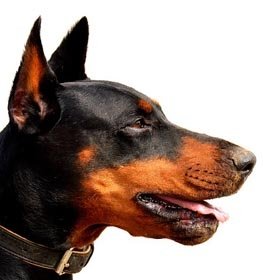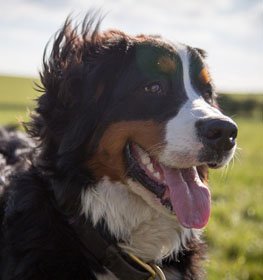Great Dane Information & Dog Breed Facts
Collection of all the general dog breed info about Great Dane so you can get to know the breed more.
| Group | Working Dogs |
|---|---|
| Popularity Rank | 14 |
| Reviews | 14 |
| User Ratings | |
|
Compare the Great Dane With Other Dogs
Select at least one dog breed to make the comparsion. | |
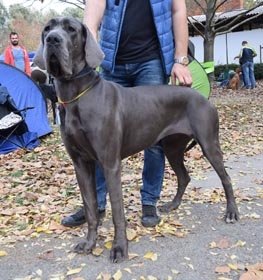 | |
| Origin | |
|
Common Names & Aliases
What other names is a Great Dane known by? Discover all traditional, regional and informal names used for this breed. | Apollo of DogsDeutsche DoggeGentle GiantGerman MastiffDane |
|---|---|
|
Breed Classification
What type of dog breed is a Great Dane? Learn about its genetic classification and breeding category. | Purebred The Great Dane is considered a purebred dog breed, but many mixes and hybrids have been created from this breed. We have compiled a list of Great Dane Mixes. |
Photo Gallery of the Great Dane Breed
|
Size Classification
What size category is a Great Dane? Learn how big the Great Dane breed typically grows. | Giant |
|---|---|
|
Weight Statistics
How much does a Great Dane weigh? Discover typical weight ranges for adult males and females of the Great Dane breed. | Male: 120-200 pounds (54-90 kg), Female: 100-130 pounds (45-59 kg) |
|
Average Weight
What is the average weight of a Great Dane? | Male: 160 pounds (72 kg), Female: 115 pounds (52 kg) |
|
Height
How tall is the Great Dane? Great Dane height: | Male: 30-34 inches (76-86 cm), Female: 28-32 inches (71-81 cm) |
|
Average Height
What is the average height of a Great Dane? | Male: 32 inches (81 cm), Female: 30 inches (76 cm) |
|
Price Range
How much does a Great Dane puppy cost? Find current market prices and factors affecting Great Dane costs. | $800-$1200 If you choose to purchase the Great Dane, you should know that the mentioned amount of money is an average of the collected data from breeders’ sites and puppy finder places. If you have a Great Dane for sale, please advertise it on a reliable website to make sure the Great Dane gets to a happy place. |
|---|---|
|
Availability
How easy is it to get a Great Dane? How many Great Dane are there in the world? | Very frequent: The Great Dane is quite easy to get. There is a risk of overbreeding, as it is an extremely popular breed. Inbreeding is common because of its popularity. A new study suggests that inbreeding contributes to the incidence of disease and health problems. So be careful, buy from a trustworthy place or kennel and seek the help of an experienced person, a professional, to make the right decision. |
|
Intelligence Rating
How intelligent is a Great Dane? Discover the Great Dane's intelligence ranking and learning capabilities. | Smart: The Great Dane dogs have great intelligence. They understand and memorize new commands in 15-25 repetitions.
The Great Dane is among the smartest dogs in the intelligence ranking. |
|---|---|
|
Training Difficulty
How easy is it to train a Great Dane? Learn about the Great Dane's trainability and response to training methods. | Great Dane dogs are quite easy to train. Sometimes they can be challenging, but if you're consistent in teaching new commands they will obey for sure. |
|
Watchdog Rating
How good is a Great Dane as a watchdog? Learn about the Great Dane's alertness and guarding instincts. | Great Dane dogs are one of the best watchdogs. Their main job is to observe and they're very consistent in their effort. The best vocal cords and sense of hearing belong to them. Usually, they're very territorial and protective about their property, so the Great Dane dogs will alert you if they sense something different. |
|
Territorial Protection
Is a Great Dane protective of its territory? Learn about the Great Dane's guarding instincts and behavior. | Great Dane dogs are extremely protective guard dogs. This breed doesn't hesitate to protect its territory so the Great Dane can be a good choice if you want an excellent guard dog. Keep calm and the Great Dane will take care of unwanted people or animals. |
|
Personality Traits
What personality does a Great Dane have? Learn about characteristic Great Dane temperament and behavior traits. | LovingIntelligentConfidentFriendlyDevotedGentleReserved |
|---|---|
|
Sensitivity Level
How sensitive are they? Great Dane sensitivity: | Sensitive: Great Dane dogs don't like an irregular daily routine, noisy household, and frequent guest visits.
This breed's emotional level reflects their owner's feelings and they don't handle punishments well. |
|
Affection Level
How affectionate are they? Is a Great Dane a good family dog? | Average: Great Dane dogs are average dogs regarding their affection level. Some breeds are forthcoming and friendly, while others are independent and don't bond too closely with their owners. |
|
Social Needs
How much social interaction does the Apollo of Dogs need? Great Dane social needs: | Great Dane dogs are a social breed. They enjoy being around people or other animals. This breed doesn't tolerate being left alone. |
|
Impulse to Wander or Roam
How likely is the Great Dane to run away? Does this breed explore or wander a lot? Does Great Dane roam? | Great Dane dogs have average wanderlust potential. Sometimes they like to explore the world and they might escape once or twice, but usually, they prefer staying safely at home. Safer to teach them how to get back to you on command. |
|
Prey Drive
Do this canine have a strong prey drive? Does Great Dane have high prey drive? | Great Dane dogs have an average prey drive, which means that they don't have a high impulse to chase and catch something like a cat or any other small aminals, but it might happen. Training can help to achieve good behavior. |
|
Barking Frequency
Does a Great Dane bark a lot? Learn about typical Great Dane vocalization patterns and triggers. | Low to Average: The Great Dane rarely barks. This breed could be a good choice if you're looking for a quiet breed. They don't bark unless there is a good reason.
Top reasons for barking: protection, alarm, fear, boredom, attention-seeking, greeting, separation anxiety, compulsive barking. |
|---|---|
|
Playful Nature
How playful is a Great Dane? Understand the typical play drive and energy level of the Great Dane breed. | Great Danes are not the most playful dog breed. Sometimes they do like playing, but that's not their favorite activity. |
|
Apartment Adaptability
Can a Great Dane live in an apartment? Learn about the Great Dane's suitability for apartment living. | Very house-friendly dog the Great Dane breed. It's good if you have a small garden where he can go out and do his business, but it's not important at all. You can get enough exercise with one or two walks a day, so keeping them indoors shouldn't be a problem. |
|
Lifestyle Adaptability
How adaptable is a Great Dane to lifestyle changes? Learn about the Great Dane's flexibility to new situations. | Average: Great Dane dogs adapt to lifestyle changes and different living environments quite okay usually. |
|---|---|
|
Alone Time Tolerance
Can a Great Dane be left alone? Learn about the Great Dane's tolerance to solitude. | Great Dane dogs do best when a family member is at home during the day or if their workplace is dog-friendly so they can take the dog at work. |
|
Bite Risk Assessment
What is a Great Dane biting potential? Learn about the Great Dane's bite risk factors. | Low 🔽 The Great Dane has a low chance of biting somebody. Top reasons for dog bite: protection, pain, excitement, herding instinct, being provoked. (Data based on the available online bite statistics.) |
|---|---|
|
Mouthing Tendency
Is a Great Dane mouthy? Learn about the Great Dane's tendency to use mouth during play. | Great Dane dogs have a higher than average tendency to nip, chew, playbite, or herd people. It's a common habit during puppyhood, not aggressive behavior. These "bites" don't hurt, but Great Dane dogs need to be taught a good attitude. |
|
Bite Strength Rating
How strong is a Great Dane bite? Learn about the Great Dane's bite force measured in PSI. | Above 400 PSI 🔼 Great Dane bite force: The Strongest. The Great Dane bite force is among the strongest in the canine world. The bite force Great Dane measurements are typically quite high, which is a testament to their powerful and large stature. The bite force of Great Dane dogs is impressive, and their Great Dane bite PSI is reflective of their powerful nature.
The Great Dane PSI bite should be respected, and appropriate precautions should be taken when interacting with these dogs. The PSI of a Great Dane bite is high, making them one of the strongest breeds in terms of bite force. They are very protective of themselves and their families, therefore a dog bite from them could be exceptionally dangerous with their PSI being above 400. To ensure a well-behaved and controlled dog, it's important to learn how to train a Great Dane puppy not to bite from an early age. It is important that they’re trained to be around others safely. |
|
Average Lifespan
How long does a Great Dane live? Learn about the typical lifespan of the Great Dane breed. | 7-11 years The average lifespan of Great Dane: 9 years |
|---|---|
|
Climate Tolerance
How well does a Great Dane handle different weather? Learn about the Great Dane's climate adaptability. | Prefers average to warm weather conditions Different dogs have different preferences when it comes to weather conditions. However, in general, most dogs prefer average to warm weather conditions, as they typically find hot weather conditions to be uncomfortable and taxing. |
|
Health Concerns
What health issues are common in a Great Dane? Discover typical conditions affecting the Great Dane breed. | Great Danes are commonly healthy dogs. Vet costs aren't expensive with this breed. |
|
Vet Care Frequency
How often does a Great Dane need vet visits? Learn about the Great Dane's veterinary care requirements. | Rare The Great Dane should have a complete physical check-up at least every 12-18 months (but preferably once per year). If your dog shows any symptoms, call your veterinarian. |
|
Health Problems
What genetic/health problems does the Great Dane breed have? What are the health issues and concerns of the Great Dane breed? Most common health risks of Great Dane: | Hip Dysplasia Patent Ductus ArteriosisCancerBloatMitral Valve DiseaseSubvalvular Aortic StenosisDilated CardiomyopathyPersistent Right Aortic ArchTricuspid Valve Dysplasia |
|
Energy Rating
How energetic is a Great Dane? Understand daily activity needs of the Great Dane breed. | Great Dane dogs are high-energy dogs. An active lifestyle makes them happy. |
|---|---|
|
Activity Requirement / Exercise Need
How much exercise does a Great Dane need? How much exercise do Great Dane dogs require per day?
Do Great Dane dogs need a lot of exercises? | Great Dane dogs exercise need is minimal. If you live a slow life, this breed can be a good choice for you. |
|
Sleeping Need
How much sleep does the Great Dane breed need? | Great Dane dogs don't need too much sleep. They are energetic and desire to live active life. If you think naps are overrated, this breed can be the best choice for you. |
|
Obesity Tendency
Is a Great Dane prone to weight gain? Learn about the Great Dane's obesity risks. | Low to Average: The Great Dane has a low to the average risk for obesity. To make your dog happy and fit, feed him with quality dry dog food and live an active life together. Try to find the happy medium between exercise and feeding.
If you notice any weight gain, consult your veterinarian and make a diet plan. Reduce unhealthy food and snacks, and measure the Great Dane weight regularly. |
|---|---|
|
Food Consumption
How much food does a Great Dane need daily? Learn about the Great Dane's feeding requirements. | 8 to 10 cups of high-quality dry food a day, divided into two meals |
|
Allergy Friendliness
Is a Great Dane hypoallergenic? Learn about the Great Dane's suitability for allergy sufferers. | No Great Dane dogs don't do well with allergy sufferers by causing allergic reactions. Some dog breeds are even considered to higher possibility of an allergic response. Coat type isn't necessarily relevant, because most people are allergic to dander (flakes on the dog's skin) or saliva, not actually to dog hair. |
|---|---|
|
Coat Colors
What colors does a Great Dane come in? Discover all possible Great Dane color variations. | Black Blue White Fawn Brindle Merle |
|
Grooming Requirements
How much grooming does a Great Dane need? Learn about Great Dane coat maintenance requirements. | Effortless: The Great Dane requires minimal grooming. Seasonal flea treatment is needed, but cutting the dog's hair by a professional groomer isn't necessary. Ears and eyes should be cleaned sometimes to avoid infections. Great Dane is one of the best choices if you don't have the time, skill, or money to take care of a high-maintenance dog. Highly recommended for beginners. |
|
Drooling Tendency
Does a Great Dane drool a lot? Learn about the Great Dane's drooling habits. | The Great Dane drools quite a lot, so if you dislike being covered by slobber spots on your clothes, you may want to choose another dog breed. Drooling is the unintentional saliva flowing outside of the mouth. It can be completely normal or a sign of a health problem. Certain dog breeds drool more than others, just like the Great Dane.
If you notice any change in your dog's drooling habit, you should contact a vet as soon as possible. |
|
Stinkiness Rating
Does a Great Dane smell bad? Learn about the Great Dane's natural odor levels. | Medium ⏺ The Great Dane has an average chance of bad smell. Top reasons for dog stinkiness: infection of bad tooth/ear/skin folds, gas attacks. |
|
Coat Characteristics
What type of coat does a Great Dane have? Learn about the Great Dane's fur characteristics. | Dense |
|
Bathing Needs
How often does a Great Dane need baths? Learn about the Great Dane's bathing requirements. | 4-6 weeks Average. Experts recommended at least every 4-6 weeks for this family pup. According to a study, 56% of pet parents don’t bathe their dogs as frequently as they should, and 60% use the sniff test when deciding when it’s bath time.
Bathing your dog is beneficial to them in more ways than just one. It’s also a good time to look for unusual scratches, bumps, fleas, and other irregularities. When their hair is wet and flat against their body, these details are more visible. |
|
Shedding Level
How much do Great Dane dogs shed? How to control, reduce and prevent the shedding of the Apollo of Dogs? Do Great Dane dogs shed a lot? | Great Dane dogs shed moderately. It's a natural process of the hair growth cycle. Regular brushing reduces the amount of hair that sheds. It mostly depends on their health status and breed type. |
|
Child Compatibility
Is a Great Dane good with children? Learn about the Great Dane's behavior around kids of different ages. | Great Dane dogs are kid-friendly dogs. This breed is a good choice if you have children. |
|---|---|
|
Pet Compatibility
How well does a Great Dane get along with other pets? Discover the Great Dane's compatibility with other animals. | Great Dane dogs are generally with other pets. |
|
Stranger Friendly
Are they aggressive or friendly towards/with strangers? Great Dane temperament with other people: | Great Dane dogs are average friendly towards strangers. |
|
Cat Friendly
How well do Great Dane dogs get along with cats? Are they good with kittens? What is this fido's temperament with cats? Can they be good with cats? Can the Great Dane breed live with a cat? | Great Dane dogs are average friendly towards cats. |
|
Dog Friendly
Is Great Dane good with other dogs? Are they dog-friendly dogs? How well do Great Dane dogs get along with other dogs? | Great Dane dogs are average friendly towards other dogs. |
|
Good For First Time Owners
Is Great Dane breed good for first-time owners? Do they make a good dog for novice owners? Is Great Dane breed suitable for first-time owners? | Yes Great Dane dogs are good for novice owners, due to their easy-going personality. |
|
Office Friendly
Are Great Dane dogs good office canines? Do Great Dane dogs make good office-friendly pets? Can they be office dogs? | No Great Dane is not the best dog breed for office environment. |
|
Senior Citizens Friendly
Are they senior citizens friendly dogs? How well do Great Dane dogs get along with the elderly people? What is the Apollo of Dogs temperament with senior people? Are Great Dane dogs good for elderly owners? | Great Danes are usually recommended for elderly people. |
|
Service Dog Capability
Can a Great Dane be a service dog? Learn about the Great Dane's service work potential. | Not really This breed generally not used as a service dog. A service dog is a term used in the USA to refer to any type of assistance dog specifically trained to help people who have disabilities, such as visual impairment, hearing impairments, mental disorders, seizures, mobility impairment, and diabetes. Service dogs are protected under the ADA (Americans with Disabilities Act).
Great Dane is not the best breed for service purposes. |
|---|---|
|
Therapy Work Suitability
Is a Great Dane good as a therapy dog? Learn about the Great Dane's therapy work aptitude. | Yes This breed makes a perfect therapy dog. A therapy dog is a dog that might be trained to provide affection, comfort, and love to people in hospitals, retirement homes, nursing homes, schools, hospices, disaster areas, and people with anxiety disorders or autism.
Great Dane breed is a good choice for therapeutic purposes. |
|
Scent Detection Ability
Is a Great Dane good at detection work? Learn about the Great Dane's scenting abilities. | Not really They are not typically employed for this type of work, but there may be exceptional cases. A detection dog or sniffer dog is a dog that is trained to use its senses (mostly its smell) to detect substances such as explosives, illegal drugs, wildlife scat, currency, blood, and contraband electronics such as illicit mobile phones.
Great Dane is not the best breed for detection purposes. |
|
Search & Rescue Potential
Can a Great Dane do search and rescue? Learn about the Great Dane's SAR capabilities. | Not really This dog breed is not typically used as a search and rescue dog. The use of dogs in search and rescue (SAR) is a valuable component in wilderness tracking, natural disasters, mass casualty events, and locating missing people.
The Great Dane is not the best breed for SAR purposes. |
|
Maritime Work Ability
Is a Great Dane good on boats? Learn about the Great Dane's maritime capabilities. | Not really Great Dane breed usually doesn't like being on a boat. Boat dogs were typically bred for their strength, stamina, and water resistance, as they were often required to perform tasks such as pulling in fishing nets, and jumping into the water to retrieve ropes or lines, or helping to move cargo. Sailor dog is a type of dog that was bred to accompany sailors on their voyages. They were typically used for three purposes: as a working dog, a watchdog, and as a companion. A boat dog is a term used to describe a type of dog that was traditionally bred and used as a working dog on boats. |
|
Draft Work Capability
Can a Great Dane pull carts? Learn about the Great Dane's drafting abilities. | Yes A drafting dog or draft dog is a dog bred and used for cart pulling. Dogs bred for this work have strong builds and qualities that are needed, strength and determination.
Great Dane breed is a good choice for drafting purposes. |
|
Military Service Background
Was a Great Dane used in military service? Learn about the Great Dane's military history. | Yes In history, this breed was unfortunately used for combat dogs. A combat dog is a specially trained dog that is used in warfare to help protect military personnel and assets. Combat dogs are often deployed in areas where there is potential for contact with the enemy, such as during raids or search operations.
Combat dogs are typically assigned to either infantry or special operations units. They are used for a variety of tasks including area security, sentry duty, trackers, and explosive detection. In addition to their combat roles, combat dogs also play an important role in troop morale by providing companionship and emotional support. |
|
Puppy Litter Size
How many puppies does a Great Dane usually have? Learn about typical litter sizes. | 10-15 puppies |
|---|---|
|
Pregnancy Duration
How long is a Great Dane pregnant? Learn about the Great Dane's gestation period. | 60-64 days Reproductive cycle of the female Great Dane: The first period called Proestrus lasts for about 9 days.
During this time the females start to attract males. You can notice by swelling vulva and bloody discharge. The second part is the Estrus when the female is receptive for the male. It lasts for about 3 to 11 days. The sign of the proestrus part is the soft and enlarged vulva. The discharge decreases and lightens in color. The third part is the Diestrus. Normally, it occurs around day 14. In this period the female’s discharge changes for vivid red and coming to its end. The vulva returns to average, and she will no longer permit mating. The fourth part called the Anestrus. The time frame between heat periods normally lasts about six months. |
|
Breeding Frequency
How often can a Great Dane have puppies? Learn about safe breeding intervals. | Once a year. More frequent breeding is not healthy. It is very important not to buy a dog from a puppy mill, where the needs of the pups and their mothers are ignored. It's an inhumane high-volume dog breeding facility, where puppies born several times a year. |
|
AKC Classification
What AKC group is a Great Dane in? Learn about the Great Dane's AKC classification. | Recognized by the American Kennel Club in 1887 as a Working breed. |
|---|---|
|
FCI Classification
What FCI group is a Great Dane in? Learn about the Great Dane's international classification. | Recognized by FCI in the Pinscher and Schnauzer - Molossoid and Swiss Mountain and Cattledogs group, in the Molossian type section. |
|
Kennel Club Recognition
Which kennel clubs recognize a Great Dane? Learn about the Great Dane's official recognition. | American Canine RegistryAmerican Kennel ClubAmerica's Pet RegistryCanadian Kennel ClubDog Registry of America Inc.Federation Cynologique InternationaleKennel Club of Great BritainNorth American Purebred Registry, Inc.American Canine Association, Inc.Australian National Kennel CouncilContinental Kennel ClubNational Kennel ClubNew Zealand Kennel ClubUnited Kennel ClubCanadian Canine Registry |
Great Dane Pros and Cons
- Intelligence Rating: Smart: The Great Dane dogs have great intelligence.
- Health Concerns: Great Danes are commonly healthy dogs.
- Apartment Adaptability: Very house-friendly dog the Great Dane breed.
- Grooming Requirements: Effortless: The Great Dane requires minimal grooming.
- Obesity Tendency: Low to Average: The Great Dane has a low to the average risk for obesity.
- Watchdog Rating: Great Dane dogs are one of the best watchdogs.
- Child Compatibility: Great Dane dogs are kid-friendly dogs.
- Senior Citizens Friendly: Great Danes are usually recommended for elderly people.
- Good For First Time Owners: Great Dane dogs are good for novice owners, due to their easy-going personality.
- Therapy Work Suitability: This breed makes a perfect therapy dog.
- Draft Work Capability: A drafting dog or draft dog is a dog bred and used for cart pulling.
- Allergy Friendliness: Great Dane dogs don't do well with allergy sufferers by causing allergic reactions.
- Drooling Tendency: The Great Dane drools quite a lot, so if you dislike being covered by slobber spots on your clothes, you may want to choose another dog breed.
- Mouthing Tendency: Great Dane dogs have a higher than average tendency to nip, chew, playbite, or herd people.
- Alone Time Tolerance: Great Dane dogs do best when a family member is at home during the day or if their workplace is dog-friendly so they can take the dog at work.
- Office Friendly: Great Dane is not the best dog breed for office environment.
Great Dane History
The Great Dane also called the Deutsche Dogge, is proven to be the tallest dog breed in the world right now. Like many other big-sized dog breeds, initially, the Great Dane was bred to be used as a wild boar hunter. The oldest records about the breed were found in Egyptian artefacts that date back to 3000 B.C.
Documents describing a similarly-looking dog breed were found from a later period, dating back to the 2000s B.C., these were found in the Mesopotamian region, however, there is also evidence suggesting that this type of dog is originating from Tibet, for the reason that Chinese writings from 1121 B.C. attesting for their existence. It is also believed that the Assyrians traded these dogs with the Romans and Greeks, spreading them all over the world during their conquests, trades, and travels. Some archaeologists even found evidence that the Great Dane type of dogs was portrayed in frescoes in Tiryns, in Greece. These wall paintings depicted large dogs during hunting for wild boar, dating back to the 13th – 14th centuries. Most presumably, during this time, the ancestors of the English Mastiff were involved in the breed’s development. Firstly, the Greeks, then the Romans also bred these larger dogs with each other, and this process eventually, reached Great Britain. In England, further breeding took place, where breeders selected the most long-legged, and strongest specimens, and bred them with each other, in order to elongate the breed’s physique, while maintaining a strong body. According to some rumours, during this period, mostly the Irish Greyhound and the Irish Wolfhound played the most important parts of the development process.
During the 16th century, many German nobles started keeping larger and larger dogs in their homes, thus the Great Dane got fairly popular in Germany. Back then in Germany, the breed was called “Chamber Dogs”, for the reason that people began to use the dogs for protecting purposes, keeping the dogs in their bed chambers at night. In most of the homes, these dogs were pampered and wore gilded collars lined with velvet, this largely contributed even further to the breed’s noble appearance. Around the late 16th century, people also used the breed for their original purpose, to hunt wild boar. The dogs’ ears were chopped, in order to prevent the boar tusks from tearing them. Later, the breed’s name was changed to “English Dogges”. The name “Great Dane” appeared in the early 18th century when a French naturalist travelled to Denmark and saw a version of the Boar Hound, a slimmer specimen, more like a Greyhound in appearance. He called the dog “Grand Danois”, which later transformed into the “Great Danish Dog”, and later to Great Dane. This naming can be deceiving, because of the fact that Denmark did not play any role in the breed’s development at all. Later, in 1880, German breeders, and dog show judges held a meeting in Berlin, where they decided to distinguish the Great Dane from all the Mastiff and Hound breeds, and they also founded the Deutscher Doggen-Klub of Germany, honouring the dog. Around this time, towards the end of the 19th century, the breed’s name was not agreed upon internationally. It was a debatable question among states. The Italians called the breed Alano, the Germans called them Deutscher Doggen, whilst the Anglo-Saxon nations knew the breed like the Great Dane. Throughout the 19th century, German breeders continued to refine the breed, with special attention to their behavioural characteristics. Breeders wanted to transform the hunting breed into a family-compatible companion.
The Great Dane Club of America was founded in 1889, the Great Dane was the fourth breed to join and to obtain recognition by the AKC (American Kennel Club). Later, Great Danes got really famous during the 20th century, when Scooby-Doo, a cartoon series for kids came out presenting a lovely, goofy detective dog, who was a brown Great Dane. Nowadays, the Great Danes are still very popular, and they are usually kept as family companions. Due to their huge size, many health-related issues can arise, unfortunately. No matter the size, the breed is a very noble, even-tempered, goofy and courageous dog, who is great with children.
Latest Great Dane Compares
Featured Great Dane Compares
Great Dane Names
How old is my Great Dane in human years?
You May Also Like
Rate The Great Dane Breed
Great Dane Comments, Reviews and Questions
- Freaky granda who’s is dead
Feb 11, 2025, 4:07:40 PM:
Sexy cousin gave the best boner that’s how we created sexy bastered
- Sexy cousin
Feb 11, 2025, 4:05:29 PM:
I agree with sexy man
- Sexy uncle
Feb 11, 2025, 4:01:39 PM:
I agree with sexy man she’s my sister she is sexy
- Sexy mam
Feb 11, 2025, 4:00:16 PM:
I agree with sexy basterd
- Sexy basterd
Feb 11, 2025, 3:51:33 PM:
I agree with sex
- Sex
Feb 11, 2025, 3:49:18 PM:
It gave me sex
- Alexander
Dec 28, 2024, 9:05:52 PM:
If you want a Great Dane get a bloodhound as they are so easy to take care of
- lamar
Jun 12, 2024, 2:34:07 AM:
- HELLO TOO BIG
Jun 12, 2024, 2:33:18 AM:
- @measuresweetness.E.X.E.
Jun 12, 2024, 2:32:17 AM:
- @measuresweetness.E.X.E.
Jun 12, 2024, 2:31:38 AM:
cool the best dog
- Luka Videos
Mar 9, 2023, 7:10:30 AM:
SO BIG
- Nia
Feb 25, 2022, 6:48:53 AM:
- Burak
Jan 30, 2020, 10:05:41 AM:
One of a kind. Once you have a great dane ,you cant stop having more.


